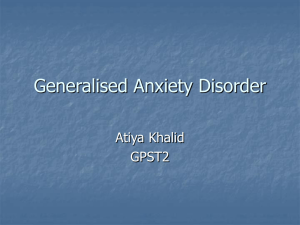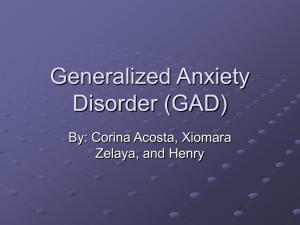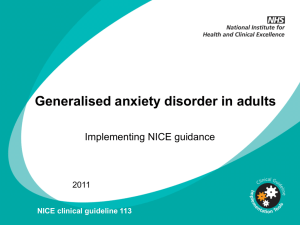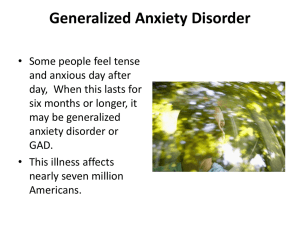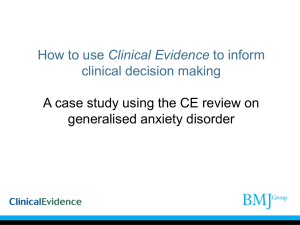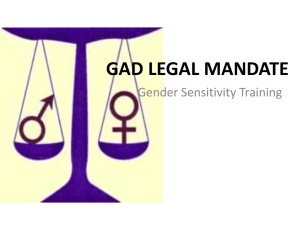project implementation, management, monitoring and evaluation stage
advertisement
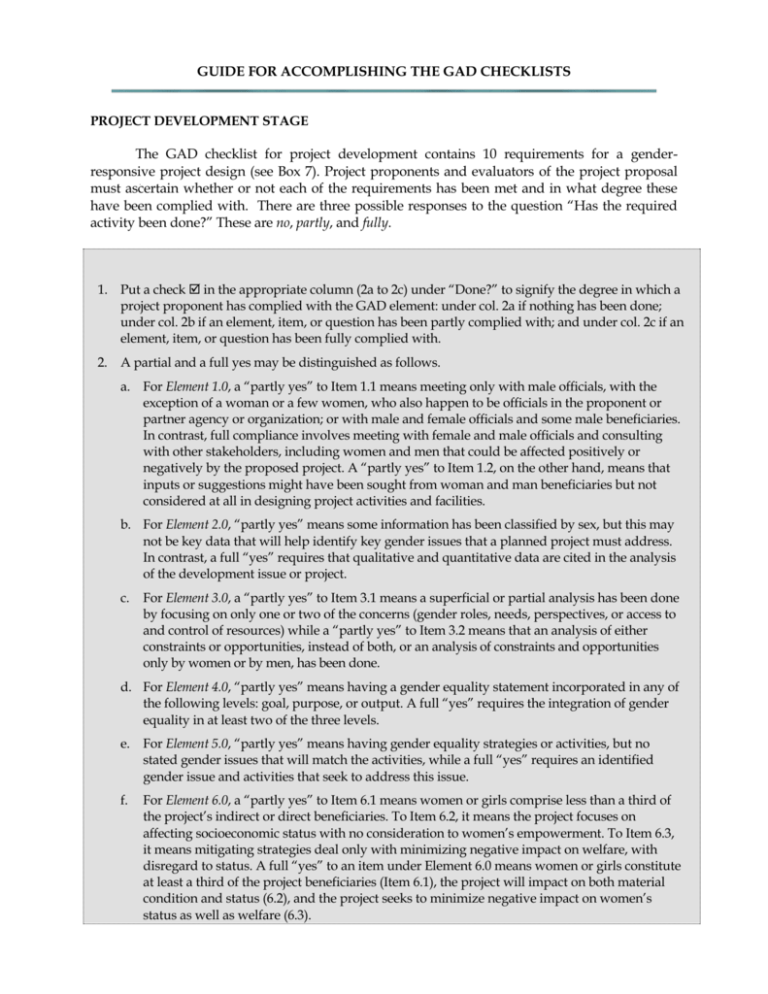
GUIDE FOR ACCOMPLISHING THE GAD CHECKLISTS PROJECT DEVELOPMENT STAGE The GAD checklist for project development contains 10 requirements for a genderresponsive project design (see Box 7). Project proponents and evaluators of the project proposal must ascertain whether or not each of the requirements has been met and in what degree these have been complied with. There are three possible responses to the question “Has the required activity been done?” These are no, partly, and fully. 1. Put a check in the appropriate column (2a to 2c) under “Done?” to signify the degree in which a project proponent has complied with the GAD element: under col. 2a if nothing has been done; under col. 2b if an element, item, or question has been partly complied with; and under col. 2c if an element, item, or question has been fully complied with. 2. A partial and a full yes may be distinguished as follows. a. For Element 1.0, a “partly yes” to Item 1.1 means meeting only with male officials, with the exception of a woman or a few women, who also happen to be officials in the proponent or partner agency or organization; or with male and female officials and some male beneficiaries. In contrast, full compliance involves meeting with female and male officials and consulting with other stakeholders, including women and men that could be affected positively or negatively by the proposed project. A “partly yes” to Item 1.2, on the other hand, means that inputs or suggestions might have been sought from woman and man beneficiaries but not considered at all in designing project activities and facilities. b. For Element 2.0, “partly yes” means some information has been classified by sex, but this may not be key data that will help identify key gender issues that a planned project must address. In contrast, a full “yes” requires that qualitative and quantitative data are cited in the analysis of the development issue or project. c. For Element 3.0, a “partly yes” to Item 3.1 means a superficial or partial analysis has been done by focusing on only one or two of the concerns (gender roles, needs, perspectives, or access to and control of resources) while a “partly yes” to Item 3.2 means that an analysis of either constraints or opportunities, instead of both, or an analysis of constraints and opportunities only by women or by men, has been done. d. For Element 4.0, “partly yes” means having a gender equality statement incorporated in any of the following levels: goal, purpose, or output. A full “yes” requires the integration of gender equality in at least two of the three levels. e. For Element 5.0, “partly yes” means having gender equality strategies or activities, but no stated gender issues that will match the activities, while a full “yes” requires an identified gender issue and activities that seek to address this issue. f. For Element 6.0, a “partly yes” to Item 6.1 means women or girls comprise less than a third of the project’s indirect or direct beneficiaries. To Item 6.2, it means the project focuses on affecting socioeconomic status with no consideration to women’s empowerment. To Item 6.3, it means mitigating strategies deal only with minimizing negative impact on welfare, with disregard to status. A full “yes” to an item under Element 6.0 means women or girls constitute at least a third of the project beneficiaries (Item 6.1), the project will impact on both material condition and status (6.2), and the project seeks to minimize negative impact on women’s status as well as welfare (6.3). g. For Element 7.0, “partly yes” means the project monitoring plan includes indicators that are sex-disaggregated, with no qualitative indicator of empowerment or status change. h. For Element 8.0, “partly yes” means the project requires the collection of some sexdisaggregated data or information, but not all the information that will track the genderdifferentiated effects of the project. A full “yes” means all sex-disaggregated data and qualitative information will be collected to help monitor the GAD outcome and output results. i. For Element 9.0, “partly yes” means there is a budget for GAD-related activities but not sufficient to ensure that the project will address relevant gender issues (9.1), or to build GAD capacities among project staff or the project agency, or to tap external GAD expertise (9.2). j. For Element 10.0, a “partly yes” to Item 10.1 means there is mention of the agency’s GAD plan but no direct connection is made to incorporate the project’s GAD efforts into the plan. To Item 10.2, there is mention of other GAD initiatives in the project coverage but no indication of how the project will build on these initiatives. To Item 10.3, it means the project has a sustainability plan for its GAD efforts but there is no mention of how these could be institutionalized within the implementing agency or its partners. 3. Enter the appropriate score for an element or item under column 3. a. To ascertain the score for a GAD element, a three-point rating scale is provided: “0” when the proponent has not accomplished any of the activities or questions listed under an element or requirement; a score that is less than the stated maximum when compliance is only partial; and “2” (for the element or requirement), or the maximum score for an item or question, when the proponent has done all the required activities. b. The scores for “partly yes” differ by element. For instance, the score for “partly yes” for Elements 2.0, 4.0, 5.0, 7.0, and 8.0 is “1.” For elements that have two or more items or questions (such as Elements 1.0, 3.0, 6.0, and 10.0), the rating for a “partial yes” is the sum of the scores of the items or questions that fall short of the maximum “2.0.” c. Because Elements 1.0 and 3.0 have been broken down into two items each, the maximum point (full “yes”) for each item is pegged at “1.0” and that for “partly yes” is “0.5.” The score for the element will be a positive number that is lower than “2.0,” the maximum score for the element. d. For Elements 6.0 and 10.0, which have three items each, the maximum score for each item is pegged at “0.67” and for “partly yes” is “0.33.” The rating for the element will be “partly yes” if the total score of the three items is positive but less than “2.0,” the maximum for the element. e. For Element 9.0, which has two items (9.1 and 9.2), the maximum score for each item is pegged at “1.0” and for “partly yes” is “0.5.” Hence, if a project scores a full “1.0” in one question but “0” in the other, or if a project scores “partly yes” (or “0.5”) in each of the two items, the total rating for Element 9.0 would be “partly yes” with a score of “1.0.” If a project scores “partly yes” (0.5) in one item but no (0) in the other, the total rating for the element will be “0.5.” 4. For an element (col. 1) that has more than one item or question, add the score for the items and enter the sum in the thickly bordered cell for the element. 5. Add the scores in the thickly bordered cells under column 3 to come up with the GAD score for the project identification stage. 6. Under the last column, indicate the key gender issues identified (for proponents) or comments on the proponent’s compliance with the requirement (for evaluators). Box 7. Summary checklist for the assessment of proposed projects Element and item/question (col.1) 1.0 Involvement of women and men (max score: 2; 1 for each item) 1.1 Participation of women and men in beneficiary groups in problem identification (possible scores: 0, 0.5, 1.0) 1.2 Participation of women and men in beneficiary groups in project design (possible scores: 0, 0.5, 1.0) 2.0 Collection of sex-disaggregated data and genderrelated information (possible scores: 0, 1.0, 2.0) 3.0 Conduct of gender analysis and identification of gender issues (max score: 2; 1 for each item) 3.1 Analysis of gender gaps and inequalities related to gender roles, perspectives and needs, or access to and control of resources (possible scores: 0, 0.5, 1.0) 3.2 Analysis of constraints and opportunities related to women and men’s participation in the project (possible scores: 0, 0.5, 1.0) 4.0 Gender equality goals, outcomes, and outputs (possible scores: 0, 1.0, 2.0) Does the project have clearly stated gender equality goals, objectives, outcomes, or outputs? 5.0 Matching of strategies with gender issues (possible scores: 0, 1.0, 2.0) Do the strategies and activities match the gender issues and gender equality goals identified? 6.0 Gender analysis of likely impacts of the project (max score: 2; for each item or question, 0.67) 6.1 Are women and girl children among the direct or indirect beneficiaries? (possible scores: 0, 0.33, 0.67) 6.2 Has the project considered its long-term impact on women’s socioeconomic status and empowerment? (possible scores: 0, 0.33, 0.67) 6.3 Has the project included strategies for avoiding or minimizing negative impact on women’s status and welfare? (possible scores: 0, 0.33, 0.67) 7.0 Monitoring targets and indicators (possible scores: 0, 1.0, 2.0) Does the project include gender equality targets and indicators to measure gender equality outputs and outcomes? 8.0 Sex-disaggregated database requirement (possible scores: 0, 1.0, 2.0) Does the project M&E system require sex-disaggregated data to be collected? No (2a) Done? (col. 2) Partly (2b) Yes (2c) Score for an item/ element* (col. 3) Results or comments (col. 4) 9.0 Resources (max score: 2; for each question, 1) 9.1 Is the project’s budget allotment sufficient for gender equality promotion or integration? OR, will the project tap counterpart funds from LGUs/partners for its GAD efforts? (possible scores: 0, 0.5, 1.0) 9.2 Does the project have the expertise in promoting gender equality and women’s empowerment? OR, does the project commit itself to investing project staff time in building capacities within the project to integrate GAD or promote gender equality? (possible scores: 0, 0.5, 1.0) 10.0 Relationship with the agency’s GAD efforts (max score: 2; for each question or item, 0.67) 10.1 Will the project build on or strengthen the agency/ NCRFW/ government’s commitment to the empowerment of women? (possible scores: 0, 0.33, 0.67) IF THE AGENCY HAS NO GAD PLAN: Will the project help in the formulation of the implementing agency’s GAD plan? 10.2 Will the project build on the initiatives or actions of other organizations in the area? (possible scores: 0, 0.33, 0.67) 10.3 Does the project have an exit plan that will ensure the sustainability of GAD efforts and benefits? (possible scores: 0, 0.33, 0.67) TOTAL GAD SCORE – PROJECT IDENTIFICATION AND DESIGN STAGES PROJECT IMPLEMENTATION, MANAGEMENT, MONITORING AND EVALUATION STAGE Box 16 contains four core elements for a gender-responsive project management and implementation, while box 17 presents the checklist for project monitoring and evaluation. Project monitors and evaluators must assess the degree to which the project meets each requirement at each of the two stages of the project cycle. The guides for accomplishing the two checklists and interpreting the total GAD score are provided below. The score for the question and the element must be entered in the relevant column in the checklists. Guide for accomplishing Box 16 1. Put a check in the appropriate cell (2a to 2c) under “Response” to signify the degree to which a project has complied with the GAD element: under col. 2a if nothing has been done; under col. 2b if an element, item, or question has been partly done or answered; and under col. 2c if an element, item, or question has not been fully complied with. 2. The “partly yes” response is relevant in the following: a. For Element 1.0, there are project managers or decision makers who are not supportive of GAD (Q1.1), or there is some, but limited, GAD expertise to ensure that all project contracts or efforts will contain or reflect relevant GAD concerns (Q1.2). b. For Element 2.0, only a few members of the project staff have competence to integrate GAD in the project (Q2.1) and project policy has little to do with the presence of women in the implementation team (Q2.2) or the internal or external evaluation teams (Q2.3). c. For Element 3.0, there is token, not consistent, participation of relevant Philippine government agency or agencies in project GAD activities (Q3.1); or some mention is made of the project’s GAD activities or plans in the agency’s GAD plan (Q3.2). d. For Element 4.0, there is some, mostly token, mention of GAD concerns or initiatives in project documents, often in a separate GAD section, not in the rest of the document (Q4.1); there is a mention of GAD initiatives but no coherent strategy for integrating GAD into the project (Q4.2); there is a budget for one (token) GAD activity (Q4.3); or involvement of men and women in various phases of subprojects or components supported by the project are limited to the project staff or agency personnel (Q4.4). 3. The response (and score) for an element will be determined as follows: a. “No” to all the items in each element means a “no” (with the associated “0” score) to the element or requirement. b. “Yes” to all the questions under an element means a “yes” (and a “2” score). c. A “no” or “partly yes” to at least one question under an element means “partly yes” to the element. The score for the element is the sum of the scores for its items or questions that falls short of the maximum “2.0.” 4. To get the total GAD rating, add all the scores of the elements (the figures in the thickly bordered cells). The maximum score is “8,” but a project may be considered as having a gender-sensitive management if it scores at least a “1” in each of the elements, for a minimum total of 4 points. A score lower than “2” in an element indicates that the project needs to improve its performance in that area. Box 16. GAD checklist for project management and implementation Element and guide question (col. 1) 1.0 Supportive project management (max score: 2; for each item, 1.0) 1.1 Is the project leadership (project steering/advisory committee or management) supportive of GAD or gender equality goals? For instance, has it mobilized adequate resources to support strategies that address gender issues or constraints to women’s and men’s participation during project implementation? (possible scores: 0, 0.5, 1.0) 1.2 Has adequate gender expertise been made available throughout the project? For example, are gender issues adequately addressed in the project management contract and scope of services? (possible scores: 0, 0.5, 1.0) 2.0 Technically competent staff or consultants (max score: 2; for each item, 0.67) 2.1 Are the project staff members technically prepared to promote gender equality or integrate GAD in their respective positions/locations? OR, is there an individual or group responsible for promoting gender equality in the project? OR, has the project tapped local gender experts to assist its staff/partners in integrating gender equality in their activities or in project operations? (possible scores: 0, 0.33, 0.67) 2.2 Does the project require the presence of women and men in the project implementation team? (possible scores: 0, 0.33, 0.67) 2.3 Does project require its monitoring and evaluation team (personnel or consultants) to have technical competence for GAD evaluation? (possible scores: 0, 0.33, 0.67) 3.0 Committed Philippine government agency (max score: 2; for each item, 1) 3.1 Are regular agency personnel involved in implementing project GAD initiatives? OR, are agency officials or personnel participating in GAD training sponsored by the project? (possible scores: 0, 0.5, 1.0) 3.2 Has the agency included the project’s GAD efforts in its GAD plans? (possible scores: 0, 0.5, 1.0) 4.0 GAD implementation processes and procedures (max score: 2; for each item, 0.5) 4.1 Do project implementation documents incorporate a discussion of GAD concerns? IF APPLICABLE: Are subproject proposals required to have explicit GAD objectives and to have been supported by gender analysis? (possible scores: 0, 0.25, 0.50) 4.2 Does the project have an operational GAD strategy? Alternately, has the project been effective in integrating GAD into the development activity? (possible scores: 0, 0.25, 0.50) 4.3 Does the project have a budget for activities that will build capacities for doing GAD tasks (gender analysis, monitoring, etc.) (possible scores: 0, 0.25, 0.50) 4.4 Does the project involve women and men in various phases of subprojects? (possible scores: 0, 0.25, 0.50) TOTAL GAD SCORE –PROJECT MANAGEMENT Response (col. 2) Partly No yes (2a) (2b) Yes (2c) Score for the item or element (col. 3) Guide for accomplishing Box 17 1. Put a check in the appropriate cell (2a to 2c) under “Response” to signify the degree to which a project has complied with the GAD element: under col. 2a if nothing has been done; under col. 2b if an element, item, or question has been partly done or answered; and under col. 2c if an element, item, or question has been fully complied with. 2. The “partly yes” response is relevant in the following: a. For Element 1.0, the project has token gender equality or GAD outcome or output (Q1.1) or uses GAD indicators in only a few activities, inputs, or outputs (Q1.2). The two instances suggest that GAD has not been integrated into the project monitoring system. b. For Element 2.0, there is token study of GAD or monitoring of GAD impact is limited to only one level of women’s empowerment and gender equality, that is, welfare, access, conscientization, participation, or control (Q2.1); classification of data by sex has been done in only one or two of the GAD areas cited (Q2.2); there is limited mention of GAD information in the GAD section of project reports (Q2.3); or when information are reported to higher levels of the project or agency, many of the data classified by sex at the field level have been lost or have become total figures for women and men (Q2.4). c. For Element 3.0, not all the improved welfare or status targets are being or have been met (Q3.1); or some or a little capacity to implement gender-sensitive projects has been developed in the implementing agency (Q3.2). d. For Element 4.0, there is little awareness within the project of gender-related effects of the way the project is being implemented; thus, very little action has been taken to address the negative gender effects. e. For Element 5.0, there is some, mostly token, mention of GAD concerns or initiatives in project documents, often in a separate GAD section, not incorporated in the entire document (Q4.1); there is mention of GAD initiatives but no coherent strategy for integrating GAD in the project (Q4.2); there is a budget for one (token) GAD activity (Q4.3); or the involvement of men and women in various phases of subprojects or components supported by the project are limited to the project staff or agency personnel (Q4.4). 3. The response (and score) for an element will be determined as follows: a. “No” to all the items in each element means a “no” (with the associated “0” score) to the element or requirement. b. “Yes” to all the questions under an element means a “yes” (and a “2” score). c. A “no” or “partly yes” to at least one question under an element means “partly yes” to the element, The score for the element is the sum of the scores for its items or questions that falls short of the maximum “2.0.” 4. To get the total GAD rating for project M&E, add all the scores of the elements (the figures in the thickly bordered cells). The maximum score for project M&E is “12 5. Add the score for box 16 to the score for project M&E to come up with the total rating for the project implementation phase. Box 17. GAD checklist for project monitoring and evaluation Element and guide question (col. 1) Response (col. 2) Partly No yes (2a) (2b) Yes (2c) Total score for the element (col. 3) 1.0 Project monitoring system being used by the project includes indicators that measure gender differences in outputs, results, and outcomes. (max score: 2; for each item, 1) 1.1 Does the project require gender-sensitive outputs and outcomes? (possible scores: 0, 0.5, 1.0) 1.2 Does the project monitor its activities, inputs, outputs, and results using GAD or gender equality indicators? (possible scores: 0, 0.5, 1.0) 2.0 Project database includes sex-disaggregated and gender-related information. (max score: 2; for each item, 0.5) 2.1 Does the project support studies to assess gender issues and impacts? OR, have sexdisaggregated data been collected on the project’s impact on women and men in connection with welfare, access to resources and benefits, awareness or consciousness raising, participation, and control? (possible scores: 0, 0.25, 0.50) 2.2 Have sex-disaggregated data been collected on the distribution of project resources to women and men, and on the participation of women and men in project activities and in decision making? IF APPLICABLE: Does the project require its subprojects to include sexdisaggregated data in their reports? (possible scores: 0, 0.25, 0.50) 2.3 Do project and subproject reports include sex-disaggregated data or cover gender equality or GAD concerns, initiatives, and results (that is, information on gender issues and how these are addressed)? (possible scores: 0, 0.25, 0.50) 2.4 Are sex-disaggregated data being “rolled up” from the field to the national level? (possible scores: 0, 0.25, 0.50) 3.0 Gender equality and women’s empowerment targets are being met. (max score: 4) 3.1 Has women’s welfare and status been improved as a result of the project? (possible scores: 0, 1.0, 2.0) Examples of indicators: The project has helped in raising the education levels and health status of disadvantaged groups of women. Women’s access to productive resources, employment opportunities, and political and legal status has improved. The project has created new opportunities or roles for women and men. Men and women have been sensitized to gender issues and women’s human rights. The project has supported or instituted strategies to overcome any adverse effects on women. The project has introduced follow-up activities to promote the sustainability of its gender equality results. There are project initiatives to ensure that improvements in the status of women and girls will be sustained and supported after project completion. 3.2 Has the project helped in developing the capacity of the implementing agency for implementing gender-sensitive projects? (possible scores: 0, 1.0, 2.0) 4.0 Project addresses gender issues arising from or during its implementation. (possible scores: 0, 1.0, 2.0) Has the project responded to gender issues that were identified during project implementation or M&E? OR: Has the project addressed gender issues arising from its implementation? Examples of gender issues: Negative effects on the gender relationship as a result of new roles or resources created for women Additional workloads for women and men Displacement of women by men Loss of access to resources because of project rules Element and guide question (col. 1) Response (col. 2) Partly No yes (2a) (2b) Yes (2c) Total score for the element (col. 3) 5.0 Participatory monitoring and evaluation processes (max score: 2; for each item, 1) 5.1 Does the project involve or consult woman and man implementors during project monitoring and evaluation? Does it involve woman and man beneficiaries? (possible scores: 0, 0.5, 1.0) 5.2 Have women and men been involved in or consulted on the assessment of the gender impacts of the project? (possible scores: 0, 0.5, 1.0) TOTAL GAD SCORE – MONITORING AND EVALUATION TOTAL GAD SCORE – PROJECT MANAGEMENT (from box 16) TOTAL GAD SCORE –PROJECT IMPLEMENTATION, MANAGEMENT, MONITORING AND EVALUATION Interpretation of the GAD score 0-3.9 GAD is invisible in the project (proposal is returned). 4.0-7.9 Proposed project has promising GAD prospects (proposal earns a “conditional pass,” pending identification of gender issue/s and strategies and activities to address these, and inclusion of the collection of sex-disaggregated data in the monitoring and evaluation plan). 8.0-14.9 Proposed project is gender-sensitive (proposal passes the GAD test). 15.0-20.0 Proposed project is gender-responsive (proponent is commended).


